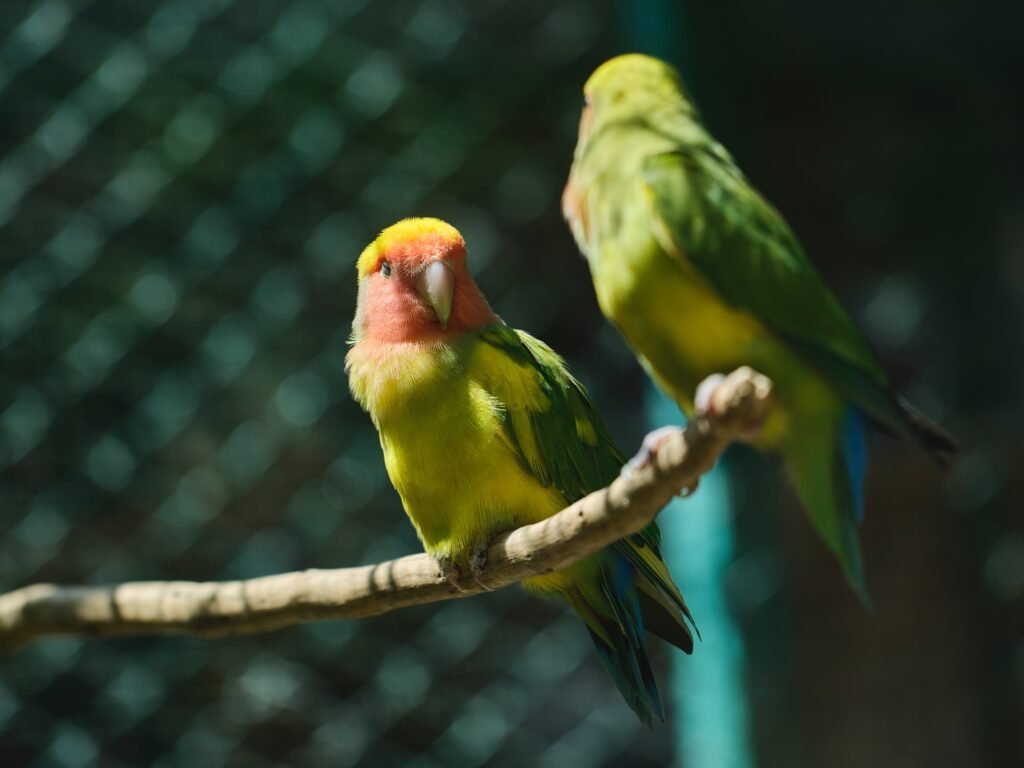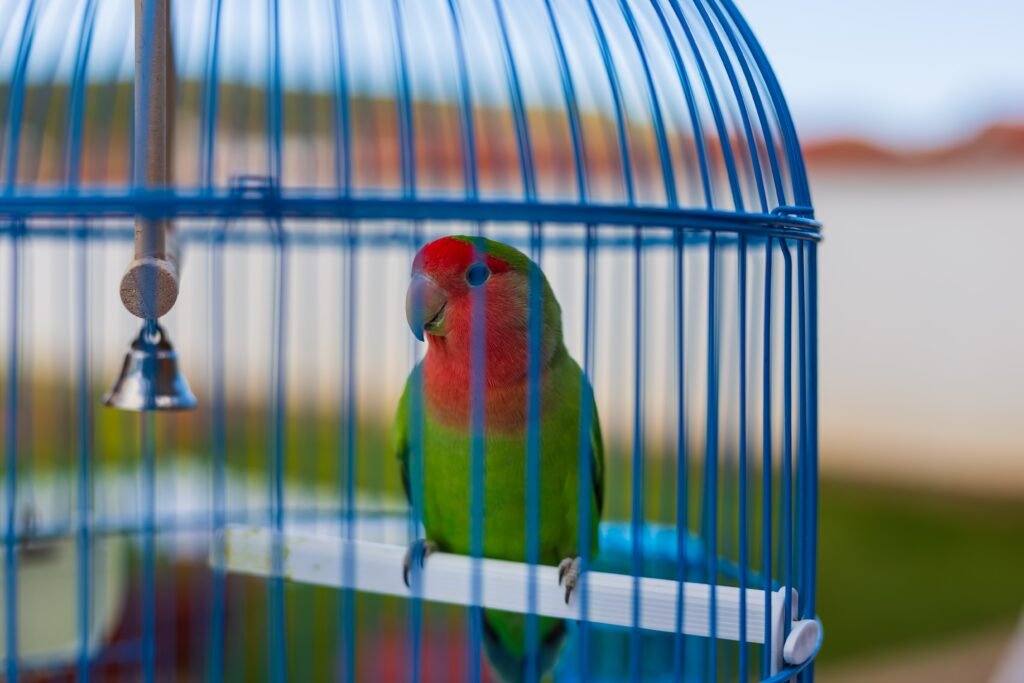
Introduction to Lovebirds and Budgies
Before we dive into the compatibility aspect, let’s familiarize ourselves with these two bird species.
Lovebirds
Lovebirds, scientifically known as Agapornis, are small parrots native to Africa. They are known for their vibrant plumage and affectionate behavior towards their mates. Lovebirds are highly social birds that thrive on companionship and interaction. They are intelligent, playful, and require mental stimulation to stay happy and healthy.
Lovebirds are available in various species, including the Peach-faced Lovebird, Fischer’s Lovebird, and the Masked Lovebird. Each species has its own unique characteristics and color variations. These birds are known for their ability to form strong bonds with their chosen mate, often displaying affectionate behavior such as preening each other’s feathers and cuddling.
Budgies
Budgerigars, commonly referred to as budgies or parakeets, are small parrots native to Australia. They are among the most popular pet birds worldwide due to their friendly nature, ease of care, and ability to mimic human speech. Budgies are social creatures that enjoy the company of their own kind but can also form strong bonds with their human caregivers.
Budgies are available in a wide range of colors and patterns, including the common green and yellow variety, as well as blue, white, and even pied variations. These birds are known for their playful and active nature, often engaging in acrobatic displays and vocalizations to communicate with their flock mates or human companions.
Understanding Compatibility
When considering housing different bird species together, it is essential to assess their compatibility. While lovebirds and budgies belong to the same family, they have distinct differences in behavior, size, and dietary requirements. Let’s explore these factors in detail.
Behavioral Differences
Lovebirds are known for their strong pair bonding and monogamous nature. They form deep emotional connections with their chosen mates and may exhibit signs of aggression towards other birds when seeking a mate or defending their territory. Lovebirds are also more likely to become territorial and possessive over their cage or nesting area.
On the other hand, budgies are generally more sociable and adaptable. They tend to be more accepting of new cage mates and are less likely to display territorial behavior. Budgies enjoy the company of other budgies and often engage in playful interactions and flocking behavior.
To ensure compatibility between lovebirds and budgies, it is important to consider the individual personalities and temperaments of the birds involved. Some lovebirds may be more tolerant and accepting of budgies, while others may display aggressive behavior. Similarly, some budgies may be more assertive and willing to establish a hierarchy within the flock, while others may be more submissive. It is advisable to introduce the birds gradually and monitor their interactions closely to ensure their well-being.
Size and Strength
Lovebirds and budgies differ significantly in terms of size and physical strength. Lovebirds are slightly larger and more robust than budgies. Their larger beaks and stronger bite force may pose a risk to budgies, especially if they feel threatened or territorial. While lovebirds are not inherently aggressive towards budgies, accidents can happen due to their size difference.
When housing lovebirds and budgies together, it is important to provide a cage that is spacious enough for both species to move around freely without feeling crowded or threatened. A general guideline is to have a cage that is at least 32 inches wide for a pair of lovebirds and an additional 12 inches for each additional bird. This will ensure that both lovebirds and budgies have enough room to exercise and explore their environment.
Dietary Requirements
Another important aspect to consider when housing different bird species together is their dietary requirements. Lovebirds and budgies have slightly different nutritional needs. Lovebirds thrive on a diet consisting mainly of fresh fruits, vegetables, pellets, and seeds. Budgies, on the other hand, require a similar diet but with a higher emphasis on seeds.
To meet the nutritional needs of both species, it is important to provide a varied diet that includes a mix of fresh fruits, vegetables, and high-quality seeds or pellets. It is crucial to ensure that both species have access to appropriate nutrition without compromising the well-being of either bird. Separate feeding stations may be necessary to monitor their intake and prevent any potential conflicts over food.
Factors to Consider
While it is possible for lovebirds and budgies to coexist in the same cage, there are several important factors to consider before making this decision. Here are some key points to keep in mind:
Cage Size
Providing an adequately sized cage is essential when housing multiple birds together. The cage should be spacious enough to accommodate both species comfortably, allowing them to move around freely and exercise. A general guideline is to have a cage that is at least 32 inches wide for a pair of lovebirds and an additional 12 inches for each additional bird. This will ensure that both lovebirds and budgies have enough room to spread their wings and engage in natural behaviors.
Cage Setup
When housing lovebirds and budgies together, it is crucial to ensure that the cage setup caters to the needs of both species. Providing multiple perches at various heights and a variety of toys and enrichment activities will help keep both birds mentally stimulated and prevent boredom. Lovebirds, in particular, enjoy climbing and exploring their environment, so providing branches or ladders in the cage will be greatly appreciated.
It is also important to provide separate areas within the cage where the birds can retreat and have some privacy if needed. This can be achieved by strategically placing birdhouses or creating small hiding spots with the help of toys or cage accessories. These hiding spots can also serve as nesting areas for lovebirds, as they often prefer a secluded and secure place to lay their eggs and raise their young.
Supervision and Monitoring
Introducing lovebirds and budgies to each other should be done gradually and under close supervision. Observing their interactions and behavior will give you valuable insights into their compatibility. If any signs of aggression or stress are observed, it may be necessary to separate the birds for their well-being.
It is important to note that lovebirds and budgies may display different body language and vocalizations when interacting with each other. Lovebirds may puff up their feathers, lean forward, or vocalize loudly as a sign of dominance or territoriality. Budgies, on the other hand, may exhibit submissive behavior by bowing their heads, crouching, or retreating from confrontations. Understanding these signals can help you assess the compatibility and well-being of the birds.
Personalities and Individual Birds
It’s important to remember that each bird has its own unique personality, and compatibility can vary from bird to bird. While some lovebirds and budgies may get along well and even form strong bonds, others may not be compatible due to individual temperaments. It is advisable to introduce new birds in a neutral environment and monitor their interactions closely before permanently housing them together.
If you already have a lovebird or budgie as a pet and are considering adding another bird to the flock, it is recommended to choose a bird with a compatible temperament. Consult with a bird expert or avian veterinarian who can guide you in selecting a bird that is likely to get along well with your existing pet. This will increase the chances of a successful and harmonious coexistence between the birds.
Conclusion
In conclusion, lovebirds and budgies can potentially live together in the same cage, but careful consideration must be given to their behavior, size, and dietary requirements. Providing a spacious cage, a suitable setup, and closely monitoring their interactions are crucial for ensuring the well-being and compatibility of both species. Always consult with a bird expert or avian veterinarian before making any decisions regarding housing multiple bird species together. By taking the necessary precautions and understanding the unique needs of each species, you can create a harmonious and enriching environment for your feathered companions.
FAQ
1. Can lovebirds and budgies live together in the same cage?
Yes, lovebirds and budgies can potentially live together in the same cage. However, it is important to consider their behavior, size, and dietary requirements before making this decision.
2. What are the behavioral differences between lovebirds and budgies?
Lovebirds are known for their strong pair bonding and monogamous nature. They may exhibit signs of aggression towards other birds when seeking a mate or defending their territory. Budgies, on the other hand, are generally more sociable and adaptable. They tend to be more accepting of new cage mates and are less likely to display territorial behavior.
3. Do lovebirds and budgies have different dietary requirements?
Lovebirds thrive on a diet consisting mainly of fresh fruits, vegetables, pellets, and seeds. Budgies require a similar diet but with a higher emphasis on seeds. It is important to provide a varied diet that includes a mix of fresh fruits, vegetables, and high-quality seeds or pellets to meet the nutritional needs of both species.
4. What factors should be considered when housing lovebirds and budgies together?
Some key factors to consider when housing lovebirds and budgies together include cage size, cage setup, supervision and monitoring, and the personalities of the individual birds. Providing a spacious cage, multiple perches, and enrichment activities is essential. Introducing the birds gradually and monitoring their interactions closely is important. Each bird has its own unique personality, so compatibility may vary. Consulting with a bird expert or avian veterinarian can help in selecting birds with compatible temperaments.



